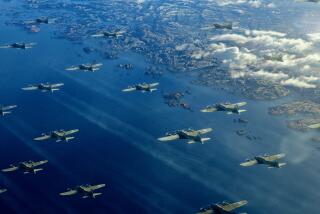NOTEBOOK : EL TORO AIR SHOW : They Flew Him for Quite a Loop
A brace of military jets shrieks overhead, and I am back in the cockpit.
I can feel my vital organs jostling for position as G-forces compress my abdomen, can taste the bile rising in my throat. I close my eyes, swallow once or twice, and exhale. Slowly.
The reverie passes, and color returns to my face.
It has been five years since the Blue Angels took me for a spin over the Southern California desert. I can’t remember the exact sequence of snap rolls and wingovers, of barrel rolls and giant loops during my hourlong flight. But the sensations--wrenching, exhilarating, deeply imprinted--are readily rekindled.
The Blue Angels fly F/A-18 Hornets now--bigger, faster and far more fearsome than the agile TA-4 in which I flew. These babies can tool along at more than 1.7 times the speed of sound.
Naval aviators piloted the F/A-18 to glory in the Gulf War; a pair of Hornets scored the Navy’s first “air kills” on the oddly suitable date of Jan. 18, downing Iraqi fighter planes and still managing to complete their bombing missions. The F/A-18’s feats also included destroying Iraqi oil refineries and military control centers at Basra.
Like everyone else, I was mesmerized by television coverage from the Persian Gulf, the interviews with the pilots fresh from their missions, those gripping cockpit videos of air-to-air combat and precision bombing raids.
As each target was reduced to dust and rubble, the video screen in the Riyadh briefing room inevitably went blank. But I could see and feel what came next: the control stick pulled sharply back, the airplane nearly vertical. And again, I’m back in the cockpit, a force five times that of the earth’s gravity driving my body into my seat.
We level off at the top of the loop, cruising upside down for a moment until a jarring snap roll puts the desert mountains once again below us, where they belong.
At this high altitude, airspeed is merely an abstraction, an incomprehensible number on a gauge above my left knee. But when the plane skims the sagebrush-dotted desert, 400 knots (more than 460 m.p.h.) suddenly becomes palpable.
A lonely palm tree seems to race madly away. A distant hillock suddenly grows to a mountain, strewn with red boulders. I’m almost certain I can feel the wind lashing my face and tousling my hair, despite the protective bubble of the canopy above my head.
A different desert, a different day. Today I’m sitting on my sofa, watching the news. But after five years, the visceral memory is resolute.
It wasn’t until we landed at El Toro that the excitement turned to outright queasiness.
My pilot, Wayne Molnar, practiced a carrier landing on the Marine Corps Air Station’s landing strip. The brakes seems to lock even before the wheels touched the ground. The seat belts cut into my chest.
I had forgotten, in the last hour or so, that there was such a state as “stationary.” This precipitous, almost violent landing was an abrupt and unpleasant reintroduction. Perhaps no one could see the bruises on my brain, but I knew they were there.
Although there had been no hostile anti-aircraft guns atop Mt. Laguna, no surface-to-air missile batteries threatening us from Borrego Springs, my olive drab flight suit had become soaked with sweat. My muscles and my mind ached. I would eat, but I would not enjoy a meal for the next two days.
Yet these pilots--Blue Angels in my memory and the aerial warriors so recently in the news--seem to scoff at Newton’s laws.
The speed and acceleration, the precise formations and dizzying maneuvers are no mere stunts, practiced only to amaze and entertain us at the air show. They are basic tools of the combat pilot’s trade. Tools which, recent events remind us all too clearly, must be used from time to time.
More to Read
Sign up for The Wild
We’ll help you find the best places to hike, bike and run, as well as the perfect silent spots for meditation and yoga.
You may occasionally receive promotional content from the Los Angeles Times.






